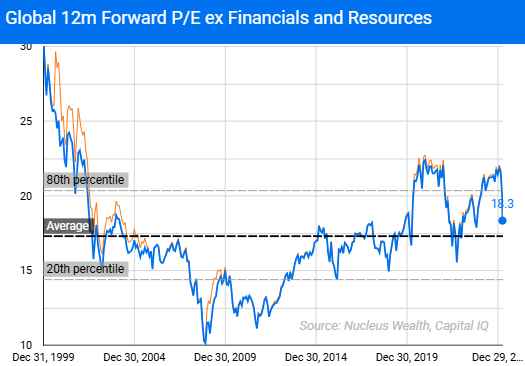The trillion-dollar question
Context is probably important here. Some investors want to hold through everything, others are more comfortable dumping everything and buying back later. I'm approaching this from a tactical asset allocation position. We want to lean into cycles: Sell some stocks when they seem overvalued, switch into bonds, then buy them back when stocks fall. But, its not about going from 0 to 100 and back again. It is about leaning into the cycle, when we are more certain and returning to benchmark when not.
We are starting from a heavily underweight stocks position, especially Australia, overweight bonds and foreign currency and we are trying to work out the right level to buy back in.
Stock markets are on sale.
It is true stock markets are currently on sale: 15-20% off their recent highs. But are stock markets offering a bargain? Or is the sale because earnings are about to become rotten?
The trade war will damage the economy. Analyst forecasts for 12%+ growth in 2025 and 2026 are wrong and will come down substantially.
Our base case is that consumers and small businesses will bear the brunt of the pain. The last few years have shown that larger companies are more likely to have the pricing power to shift most of the burden to others. But they won’t be immune.
The bear case for large companies is that this morphs into a deep global recession, weak growth smashing demand and increasing unemployment. However, the US Central Bank is reticent about cutting rates because of the impact of tariffs on inflation. The more reciprocal tariffs, the deeper the recession.
The bull case is a mix of various hopes:
- Maybe Trump will change his mind.
- Maybe Trump will be overruled by the House and Senate sometime soon. At worst in a little less than two years after the mid-terms.
- Tax cuts and stimulus are probably coming soon(ish). The mayhem around tariffs may accelerate the process.
- The US Fed may ride to the rescue with deep interest rate cuts and liquidity.
- The rest of the world remains OK, government stimulus and lower interest rates offset US weakness.
If this is the case then earnings are just trimmed, not slashed.
Our base case is somewhere in-between. Earnings get hit, growth slows markedly, then the calvary arrives with stimulus, interest rate cuts and tax cuts. Too late to save the economy from a sharp slowdown / mild recession, but early enough to avoid a deep recession.
Back-of-the-envelope maths
These numbers assume US markets are off another 3–4% Monday, as futures are indicating.
Global markets, ex financials and resources at 4pm Australian time Monday were on 18.3x forward earnings, if we factor in the drop futures are suggesting then it will be 17.5x:

That is bang on the average for the past 25 years. It will be 5% below the 10-year average. In the last few downturns, valuations bottomed out at levels 10-15% below today’s prices. But, that assumes no change to earnings. Take another 10% off earnings, and that would suggest markets could fall 20%(ish) from here if (a) earnings fall and (b) they bottom out at similar valuation levels to prior crises.
What are the big issues with that analysis? First, the earnings band of possibilities is wide. Really wide. A full-blown recession could see earnings off 25%. A mild slowdown might see earnings only off 5%.
More importantly, markets rocketed off those bottoms every time. You had a few days to grab those lows before they were gone. It is not realistic to expect that you can pick the bottom exactly.
Musings on the bottom
We are definitely looking at stocks today which we think are bargains. In a round number sense, at an S&P 500 index level of 4,600 is a rough target for wanting to buy – IF the fundamental outlook is similar to today. That level will change if the outlook gets worse or better.
In the low 4,000s we are likely closing our eyes and buying stocks.
Australian thoughts
China may decide to re-stimulate the property market. It is bad policy. China knows it, but maybe China thinks it has no other choice. That is the key to watch. That would be a big positive for Australia. Otherwise, Australia is likely to suffer as China does.
Australia, as a small consumer and large exporter, lives in a glass house. It is unlikely to want to throw any tariff stones.
But, that means a flood of cheap goods will be diverted from the US to any country that will take them. Which will be another nail in the coffin for what is left of local manufacturers. And, the end of goods inflation. With weak global growth, energy prices will finally ease, and we expect rate cuts to be the order of the day.
This means a lower Australian dollar, lower interest rates. If immigration continues to be high, then house prices may well be strong.
Is there method behind the tariff madness?
I suspect less than you might like. But, there are suggestions of a “Mar-a-lago Accord” based on a paper by Stephen Miran, who is the Chairman of the Council of Economic Advisors. He has publicly said that people are reading too much into his paper. But, the Project 2025 authors said the same. So who knows?
The paper basically says the US dollar is too high and creates trade deficits. To fix:
- The US needs to create bargaining leverage. They can do this through tariffs and security zone withdrawal threats.
- Then, the US exploit the leverage. They do this through deals with individual countries to increase their currency / lower the USD in return for lower tariffs / security “guarantees”.
The above is a greatly simplified summary. And there are a bunch of other assumptions, questions and possible unintended consequences. Not least what a Trump security "guarantee" even is. But it seems like step 1 is largely complete.
The other broad macro outcome comes from Treasury Secretary Scott Bessent. Bessent is looking for 3-3-3. 3% GDP growth, 3% bonds and a 3% gov’t deficit. Basically, he wants to reduce the public sector and then release private sector through reduced regulation and less “crowding out“.
What can go wrong?
Both of the above plans ask for short-term pain in return for a longer-term gain. Slow the US economy down now in order to have it roaring by the mid-term elections.
There are three things that can go wrong:
- The theory might be wrong. In my view the broad thrust is OK, but the details matter. The argument that the pendulum has swung too far toward low tariffs might have merit. Particularly for countries like China. The response being to shove the pendulum further in the opposite direction than it has ever been doesn’t feel like the right answer.
- The execution could go wrong. The slowdown might spiral out of control. A well-articulated trade policy that uses high tariffs as a stick and low or zero tariffs as a carrot could well be the answer. Tariffs that are here one day, gone the next, and then back again on the third day are probably not the answer.
- Trump might change his mind. After a few months of short-term pain, could Trump fire Bessent and Miran, turning to a new economic svengali? Sure. Who knows what comes then.
What is the reward?
The perfect outcome for Trump is a Reagan/Thatcher-style economic boom as companies are set free. Earnings boom for stocks.
The alternative is stagflation. A low growth, high inflation economy. And maybe a reasonable-sized recession in the interim.
Markets have switched from pricing the former to the latter.
The difference in stock earnings is night and day between the two options. The real change in risk has been all about the execution of the plan. To put it lightly, complicated execution plans do not seem to be Trump’s forte.
Net effect
We are expecting company earnings to get hit, economic growth to slow markedly. Then we expect the calvary to arrive with stimulus, interest rate cuts and tax cuts. Too late to save the economy from a sharp slowdown / mild recession, but early enough to avoid a deep recession.
But, it is not not time to be dogmatic in our outlook. Markets are going to be volatile. The cavalry might arrive earlier, it might arrive too late. When it does, markets will probably rally faster than you have a chance to buy.
For buy-and-hold investors with a long term outlook, you have a chance to buy at 25 year average valuation rates, and at a reasonable discount to the 10 year average. Absent a true disaster, returns are likely to be solid. Maybe you can time the bottom better, maybe not. It is worth considering.

